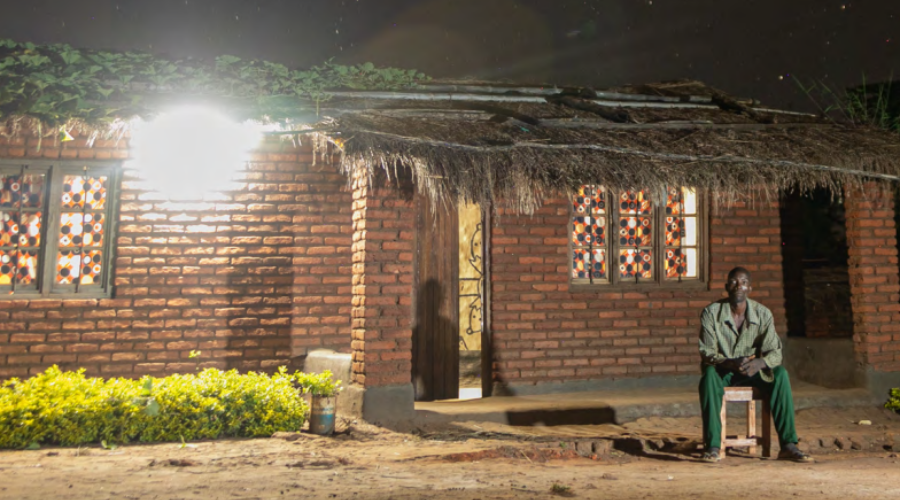SolarAid: Lighting the way
In a piece originally published by Civil Society magazine, Richard Turner highlights how SolarAid took a strategic phased approach to raising £1 million over three years. He also includes useful top tips to help you secure funding for your next new idea. Richard is SolarAid’s director of fundraising, a trustee of the SOFII Foundation and a member of the SOFII One Hundred.
- Written by
- Richard Turner
- Added
- October 01, 2024

In July 2024, SolarAid received the Charity Award for International Aid and Development for a project in Malawi that we call ‘Light a Village’. In the context of a global energy crisis, it is an amazing initiative, enabling people in one of the poorest communities in Malawi to pay for energy – making it sustainable and scalable.
But the story behind the project’s fundraising is also one worth sharing. Over three years, we raised just shy of £1 million from a range of sources.
Different strategies
Light a Village had three phases – one a year. Fundraising for each phase had a different strategy to help us decide where to apply our limited resources.
The first phase was the riskiest. We had an idea – but it was unproven. The project idea was based on insights from our work in the field where families struggled to buy solar home systems that would transform their lives. Our idea was pioneering but simple: SolarAid would install the systems at no cost to the household, but they would pay for the energy they used at a price they could afford. These payments would cover the cost of maintaining the systems, such as replacing the batteries, in future years.
So how would we fundraise for this brilliant idea?
The insight I learned years ago is that the more people that are involved in a decision to donate money, the less risk they will take. It seems people don’t like to take risks when deciding on giving away someone else’s money. So, an individual philanthropist is more likely to support an unproven initiative in its early stages than an institution or foundation with a group of staff assigned to approve grants, or a government department allocating public funds.
Hence, our strategy to fund the first phase was to approach an individual. A venture-philanthropist, and co-founder of the Turner Kirk Trust, had funded SolarAid in the past and was willing to consider initiatives we believed in but were unproven. After presenting the idea, and with approval from its co-founder, the Turner Kirk Trust agreed to fund the first phase with a donation of £75,000.
With this donation, the first solar home systems were installed in a village cluster of 500 homes in Kasakula, a remote community in the Ntchisi District of Malawi. There were problems we didn’t anticipate, for example that rats would chew through the cables, but there was lots of learning and the usage was off the scale.
So, phase two went ahead – increasing the number of households five-fold to 2,500. This would require £240,000. The Turner Kirk Trust offered to fund half if we could raise the rest. Now we had a target of £120,000.
This time we had proof that the concept worked in principle, along with some great content and stories.
Over the course of six months, we approached a range of funders who we thought would be excited to fund this initiative and give a gift of £10,000 to £20,000. This included individuals who had supported us in the past, but also new and existing foundations which would also be attracted by leveraging the match funds. In all, we secured 10 funders, including individuals, trusts and a corporate.
In May of 2022, the next batch of solar home systems were installed. Once again, the take-up was high and we continued to learn from the problems that arose and the data we gathered.
Reaching every household
Phase three was then planned – this time to reach every household in Kasakula. This would be an estimated 7,500 households – a threefold increase and would need us to raise over £600,000. This time the Turner Kirk Trust said it had helped us reach this far but we needed to secure all the funds for this final stage. It was clear that donations of £10,000 to £20,000 would not suffice as it would take too long and would involve too many funders to handle, so we focused on funders able to give £50,000 or more.
Funders at this higher level need more proof, but now we had the data from phase two. Several of the funders from the first stage pledged to support us again. EDF Renewables – part of EDF Energy – stepped up its funding from £20,000 to £60,000.
A foundation on the verge of dropping SolarAid asked to hear more once we shared our new strategy and mentioned the Light a Village initiative. It saw its potential to scale and committed £50,000 if all the other funds were raised.
We also had something to talk about at relevant conferences and forums related to off-grid energy by passionate staff who knew the project. They successfully engaged funders through conversations at workshops and side meetings who were interested in the model and the results we were already achieving. In effect, we were invited to apply for funds. At this level, we also found funders which were known to each other that may support us as a collective. If one said yes, the others were more likely to.
In May 2023, with over half the phase-three funds raised, a further 1,500 solar systems were installed taking us up to 4,000 homes. By June 2023, we secured all the funding for phase three with an average grant of £67,000 from nine funders in total.
By the end of this year, we expect to achieve 100 per cent reach to all 7,500 households in Kasakula. This is a game changer. We now have the makings of a sustainable business model that can be scaled across Malawi and replicated elsewhere in sub-Saharan Africa.
Top tips on getting funding for a new idea:
- At the outset of a new idea, go to funders where there is a clear decision-maker to give you an initial donation – ideally one person versus a committee or a group.
- Break fundraising for a large project into stages and identify the types of prospects appropriate for each stage. Estimate the number of funders you can handle to determine the average donation you will be seeking.
- Give each funding prospect a percentage chance and keep adding to your list of prospects until the amount to ask multiplied by the percentage chance adds up to the total you are seeking. So, a £50,000 grant with an 80 per cent chance would be £40,000 towards your target. We call this a ‘funding alligator’ as it chomps down a target into bite-sized pieces.
- Tell each prospect the full picture to show how their contribution fits within the whole amount you are seeking for that stage.
- Always listen to all your funders as you build your relationship then you will know what ticks their box and can approach them with something appropriate. We had very few rejections – and any rejection only came from cold approaches.
- As you start to get results, engage funders that need more proof. They will take the longest to decide but will potentially have the largest amount of funds.
- Bring funders along with you – early supporters will be delighted by how their initial support has leveraged further income. Some will continue to give.
© IMAGES: All courtesy of SolarAid
Editor’s note: SOFII are very grateful to Civil Society and Richard Turner for allowing us to share this article with our global readers. The original article can be found, here.

















